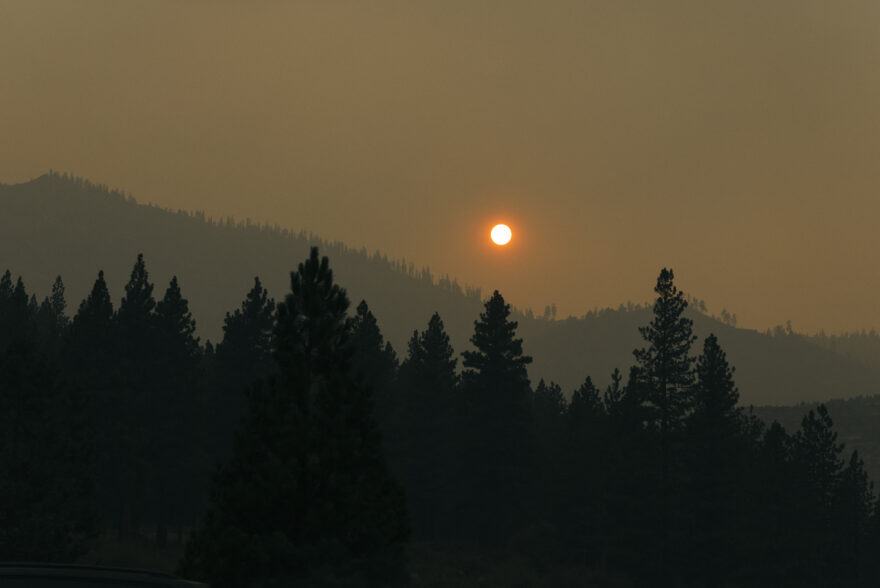State of the 2024 Wildfire Season Mini-Blog


With months still remaining before it ends, the 2024 wildfire season is already notable.
Written by: Kirsten Hodgson, Senior Science Communications Associate
In Butte County, the Park Fire is the largest active wildfire burning in California. At nearly 430,000 acres, it is also the fourth largest wildfire in state history and, as of August 17th, is 50% contained (1). Meanwhile, by early August more than 1.4 million acres had burned in Oregon this year due to wildfires, the most on record (2). Several of this year’s large wildfires are expected to burn until the fall, like 3 in the Pacific Northwest which will likely not be fully extinguished until the first significant rain or snow events of the year (3). The smoke plumes from fires like these can and do travel many miles from the fire’s perimeter, exposing communities across the U.S. and beyond to potential harm from poor air quality, like much of the Northeast experienced during last year’s Canadian wildfires (4,5). The poor air quality is back in New York City this year, again due to traveling wildfire smoke from fires burning in Canada (6).
This fire season follows a few years of relatively mild wildfire activity, which were largely attributed to higher than average levels of precipitation in the past few winters. The 2022-2023 water year was one of the 10 wettest years on record in California, and the winter of 2023-2024 was wetter than average across most of the west (7,8). Fast forward a few months and cities across the country, including many parts of the western U.S., are breaking their daily heat records (9). Swings in precipitation and temperature on relatively short timescales like this are part of a phenomenon known as climate whiplash, a feature of climate change which is expected to become more common in the coming decades (10). Climate whiplash contributes to high activity fire seasons by causing the rapid growth and buildup of vegetation during wet years, followed by this vegetation becoming extremely dry and ignitable during dry years. This is one of many factors contributing to the increase in acres burned at high severity in the western U.S. in recent years: a paradigm of fire suppression following the forced removal of Indigenous Peoples, active stewards of the land, as well as increased human residence in and near natural areas, also contribute to this trend (11). Ecological restoration treatments, including fuels reduction and prescribed fire, are a critically important tool to help mitigate wildfire risk and increase forest resilience to fire and climate change in the western U.S.
The costs of these fires are potentially massive and the impacts are diverse and widespread (12). Fire not only causes the loss of homes and other buildings, it can lead to decreased job availability; lost access to important resources like water, culturally important places, and recreation locations; and can threaten people’s lives and their health through exposure to fire and to smoke. Many people will experience the impacts of these worsening fire seasons in myriad ways. At Blue Forest, our hearts and minds are with everyone who’s experiencing this year’s wildfires, including community members and our partners who are on the ground working to keep their communities safe. On our end, we’re continuing to work to bring science, finance, and people together to make ecological restoration happen now.
Sources:
(1) https://www.fire.ca.gov/incidents/2024/7/24/park-fire/updates/587ef9e8-34fc-464d-b518-fd507da2dfd5
(2) https://apnews.com/article/oregon-wildfires-record-9454144518d25686fa70940331ffdbab
(3) https://www.king5.com/article/news/local/wildfire/3-wildfires-burn-fall-washington-state-pioneer-fire-miners-complex-moss-mountain-fire/281-c511db8f-4319-4ee2-b50c-df91c25be84c
(4) https://www.blueforest.org/science/reports-resources/the-human-health-benefits-of-improving-forest-health-in-california/
(5) https://fire.airnow.gov/#close
(6) https://www.fox5ny.com/news/weather-nyc-canadian-wildfires-smoke-haze
(7) https://www.nytimes.com/2023/10/16/us/california-rainfall-weather.html
(8) https://weatherwest.com/archives/37923
(9) https://www.forbes.com/sites/brianbushard/2024/07/23/world-records-hottest-day-ever-here-are-the-us-cities-breaking-heat-records-this-summer/
(10) https://www.nrdc.org/stories/californias-climate-whiplash
(11) https://agupubs.onlinelibrary.wiley.com/doi/10.1029/2020GL089858
(12) https://www.forbes.com/sites/jamiehailstone/2024/08/14/wildfires-costing-the-us-89-billion-in-lost-output-study-finds/